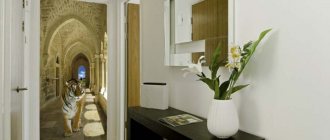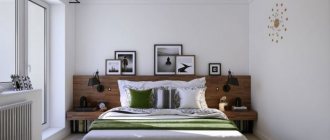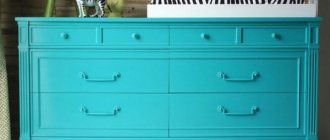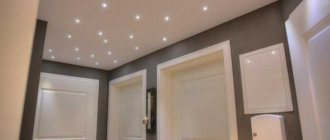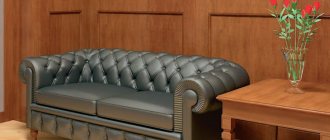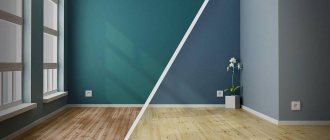Choosing the right wall color
In most cases, hallways are small. Basically, these are square or elongated rooms. The small area limits the choice, but there are criteria that should be taken into account:
- Area and layout of the premises. The smaller the hallway, the brighter the interior should be. A large corridor in a private house can be decorated in shades of dark colors, but for a small room it is worth choosing lighter shades.
- A stylistic direction that is used for interior design. Each style has characteristic features that you need to use to create a beautiful and stylish hallway.
- Features of the layout. In order to visually reduce a long corridor or increase the height of the ceilings, you should choose wallpaper with vertical stripes. To lengthen the room, a horizontal strip on the walls is suitable.
- Lighting affects the overall perception of the interior. Many corridors lack windows; the lack of natural light can be compensated for by placing artificial light sources. Good light will help highlight the color of the walls.
- It is not recommended to use more than 3 shades to decorate a hallway.
When choosing materials, it is worth considering the load on this functional area. Every day residents leave the house and return back. Depending on weather conditions, wet clothes, dirty shoes and wet umbrellas may appear in the hallway. Preference should be given to materials that are resistant to dirt and moisture. It would be appropriate to replace the snow-white shade of the walls with beige or cream.
Interior and lighting of the hallway Source Fashionable kitchen
Decoration for a small hallway
Small rooms require a particularly careful design approach. What color should I paint the room? It is not recommended to make the walls in such hallways monochromatic. For visual expansion, it is recommended to use horizontal stripes. Vertical lines will correct low ceilings, visually lifting them. The pattern does not always have to be straight lines; a pattern directed horizontally or vertically is sufficient.
The color scheme in a small corridor should not be too dark. It is best to paint in light cinnamon and beige shades with white and off-white trim. An interesting solution would be white and brown striped teeth. A white horizontal stripe on the wall under the ceiling will visually raise it. You can also use mirrors and metal trim pieces to expand the space.
Small rooms are very capricious in terms of design. The emphasis should be on functionality, but at the same time avoiding exaggerated minimalism.
Natural materials look good in a small apartment. Light wood trim will create a warm and cozy atmosphere, and if installed correctly, it will last for many years.
Article on the topic: Hallway - interesting interior in Khrushchev
Universal colors, their features
The hallway connects the apartment or house with the outside world. Only the necessary furniture intended for storing clothes is placed in a small area. You can decorate the room by decorating the walls and using a small number of decorative elements.
As the main color, you should choose universal shades that look harmonious in any interior; you can easily match them with bright decor. The main color should occupy about 70% of the entire interior, the number of bright spots should not exceed 30%.
Universal shades that are perfect for hallway design include:
- light yellow;
- beige;
- sand;
- terracotta;
- cream;
- peach;
- mint;
- grey;
- pearl gray;
- coffee with milk;
- lilac.
Light gray walls in the hallway Source artsten.ru
Gray tones in combination with beige, many mirror surfaces, and white accents allow you to create a stylish interior. Gloss and many mirrors visually increase the space. Depending on what effect you want to achieve, you should decide what color to paint the corridor.
Warm shade for wall decoration Source mebelvdome.org
Shades of bright colors enliven the interior and give it a mood. Painted mustard walls highlight the neutral beige doors and brown wardrobe. Despite the lack of lighting, the hallway is warm and cozy.
The optimal solution for decorating a hallway is natural shades chosen for the base, and bright spots that dilute the boring design. The living space, the design of which is made in a single color scheme, looks stylish and complete.
The color difference allows you to harmonize the interior, which also gives the interior a sense of dynamics. For this purpose, various combined colors or several shades of the same color are suitable.
Options for color combinations in the hallway
When choosing a color palette for the hallway, you need to focus on the “rule of three colors.” Having decided which color will play the main role, you can decide which ones will complement it. If you plan to paint the corridor in neutral colors and without sharp accents, then it is better to choose shades that are similar in palette - soft transitions will not begin to irritate over time. For example, a combination of milky and beige, brown and gray, turquoise and blue.
And when you want contrast, white will be an excellent match for any color. The combination of rich shades of walls, white furniture and doors looks impressive. In this case, the ceiling and flooring should be made neutral.
In the case of bright furniture, the best solution would be to paint the walls in light shades, for example light gray, which goes well with orange or bright green.
In order to place bright accents, modern lamps, a spectacular hanger for outerwear, a mirror in an interesting frame or beautiful paintings will come in handy.
Classic style - colors for walls
When you need to design an interior that will remain relevant for a long time, you should give preference to the classic style. This direction is characterized by rigor, elegance and functionality. Natural materials are ideal for finishing and decorating a room:
- Fine wood or stone tiles, such as marble, are suitable for the floor.
- They make stucco on the ceiling.
- It is better to choose plaster cornices.
- For walls, paint with a matte finish, wallpaper with ornaments, and decorative plaster are suitable.
Interior design of a bright hallway Source design-homes.ru
Designers advise painting the walls in the hallway:
- white;
- gray;
- beige;
- olive;
- burgundy;
- brown;
- purple.
The classic style welcomes light and muted colors. Plain wallpaper, Venetian plaster, and paint are suitable for wall decoration. The hallway should be painted in a single color scheme; the material may contain a light pattern or design.
Carvings, columns and stucco will help complement the monochromatic design. Also, as decoration you can use natural materials, mirrors, luxurious wall lamps, which will be combined with the main lighting fixtures in the corridor.
Classic corridor design Source prihozhaya.guru
In the presented version, the walls are painted with beige paint, and black and white tiles with squares were used to decorate the floor. Mirrored cabinet doors increase the space and, by reflecting the flow of light, create interesting shimmers. To decorate the hallway, we hung a luxurious chandelier and installed a decorative vase in the corner.
Light shades are better than others for decorating a hallway in a classic style. In combination with light furniture and decorative elements, the interior looks luxurious and majestic.
Shades of dark colors can be used for spacious hallways. It is important to provide good lighting that will highlight the chosen wall color or pattern.
Interior design of a narrow corridor Source yellowhome.ru
The walls of a traditional classic hallway are predominantly light and warm. All details are harmoniously combined with each other; there are many unusual and beautiful decorative elements in the room. Neoclassicism is characterized by a wider range of colors. Contrasting colors and bright details can be used.
Backlight
Lighting is used to zone rooms or create accents on certain details. A place with mandatory enhanced lighting is next to the mirror. You can experiment with other areas of the corridor.
Colored lighting in a hallway with plain walls will create a completely different mood. And the color of the lamp is easy to change if desired.
The color of the light source also plays an important role. Green is best used in the relaxation area, golden or pinkish in front of the mirror. Cool tones visually expand the rooms. Movable lighting fixtures will create an interesting effect in any functional area.
Before choosing what color to paint the hallway, you need to take into account all the functional features so that the color scheme improves the appearance of the hallway. A good hallway interior is very important because it sets the mood when you enter your home.
Article on the topic: Decorating a small hallway in a Khrushchev apartment: techniques for visually enlarging the room
Hallway in white and brown tones (2 videos)
Color options for the hallway (38 photos)
The best posts
- Hallway interior: color and design (+30 photos)
- Hallway - interesting interior in Khrushchev
- Design of a corridor in an apartment (+50 photos)
- Long hallway design ideas: accents and interesting solutions
- Decorating a hallway in Provence style: photos of interiors and general tips
- Choosing a color for the hallway: a harmonious combination of shades in accordance with the interior style
- Mirrors of various shapes and types for the hallway
- Interior of a long corridor - planning a narrow space
Choosing a color for a narrow hallway
The main task of designing a narrow hallway is the correct placement of furniture and visual expansion of the space. Light color of the walls and ceiling will help to visually raise the ceiling. Enlarged doorways will add solemnity to a narrow hallway.
By using zoning for the entrance and lobby areas, you can create the correct proportions in the room. Different stylistic directions, light, color, floor and ceiling finishing will allow you to highlight functional areas.
Colors and their combinations in the interior of the hallway
What color to choose for the hallway?
Since hallways are most often small in size and at the same time they form the first impression of the home, you should approach the issue of their design carefully.
Factors to consider when choosing hallway color
Designers recommend considering the following factors:
- Room area. The light color of the hallway will visually expand the space. Dark colors conceal the area.
- Style. Many styles have certain color schemes, so use them.
- Form. Walls with vertical stripes will “raise” the ceiling, and horizontal stripes will lengthen the room. Striped wallpaper is often used for such purposes.
Popular styles and their associated colors
As mentioned above, the color in the hallway interior largely depends on the style of the room.
Let's look at the colors characteristic of popular styles:
- Art Nouveau (modern) and classic - sand, pastel and wood shades, white, green.
- Baroque and Empire - gold, white, red, turquoise, blue.
- Rococo – gold, pink, turquoise, cream, white.
- Minimalism – gray, black, white, as well as pastel colors.
- High-tech – metallic shades, white, black.
- Fusion - characterized by non-standard color combinations - bright pink and golden, rich light green and muted pastel tones.
Is white color appropriate?
The main color of the hallway in the apartment can be white. But this solution is rarely used, even if white suits all the parameters. It's not practical.
Guests crowd in the hallway, leaving their shoes and outerwear, sometimes wet after the rain. Therefore, over time, the coatings will lose their whiteness, and any abrasions will be very noticeable.
A good alternative to white is ivory. The shade is rich, goes well with many colors and looks presentable.
Gray hallway
Unlike white, gray is much more practical and its advantages do not end there. This color includes many shades - the color of asphalt, metallic, pearl. Such scales have a positive effect. They relax and relieve tension. However, a gray hallway, where gloomy shades predominate, can be depressing and cause boredom.
It is recommended to give preference to light shades of gray, which will make the room airy, fresh and spacious. Textured surfaces add variety to the interior of a gray hallway. The texture can be created using decorative plaster.
Options for color combinations in the hallway
Color combinations can be divided into several categories:
Similar colors
This is the optimal choice for those who want to decorate the interior in one color spectrum, and at the same time want the decor to be expressive. An example of using similar colors is classic green, light green, turquoise, olive, bright lime.
When deciding to use similar colors, designers still recommend adding tones, at least in the form of inclusions, from other spectrums.
Contrasts
An interesting and bold solution that should fit into the overall decor of the hallway.
Options for using contrasts:
- Floor and walls; floor and furniture; walls and furniture; floor, walls and door.
- Small interior elements or decor that contrasts in color with the main color scheme.
- Bright, rich patterns are set against a background of muted tones.
Design and color of wallpaper in the hallway
Wallpaper designs are:
Plain
This color of the walls in the hallway will not distract attention and will allow you to focus it on other interior items, for example, on decorative elements. Plain wallpaper looks laconic and does not overload the eye. If the color of the wallpaper in the hallway is gray or pastel, it will complement minimalism, and metallic shades will emphasize hi-tech.
With stripes.
We already mentioned the stripe effect in the first section. We would like to add that the stripes should not be too contrasting and expressive in order to avoid the well effect.
Abstract
Abstract patterns come in a variety of forms, from easy-to-understand shapes to intricate patterns that can produce interesting visual effects (rotating circles, protruding squares). You should refrain from the second option, since psychological comfort in the room is important and not all residents will like this solution.
Easy-to-understand forms should be combined with the style of the interior. For example, some directions are characterized by geometry, while others are characterized by smooth shapes and lines. The background and patterns should not be too contrasting in hallways with a large wall area.
Textured
Textured wallpaper imitates many materials - wood, stone, marble, brick, plaster. There are also exotic options - imitation animal skins or tribal huts. This solution allows you to complement the interior style, whatever it may be, except for options when you need to implement minimalism using plain and smooth wallpaper.
Hallway floor color
Perhaps many people believe that the most optimal floor color in the hallway is dark. It is non-staining and practical, and there is some truth in this. However, high-quality floor finishing materials can be abrasion-resistant and durable. Therefore, designers successfully use not only dark colors, but also lighter tones, for example, if they need to implement a Scandinavian style.
We suggest considering design solutions for choosing the floor color for the hallway.
- For the floor of a small hallway, choose light and cool shades - blue, light blue, gray. Floor tiles made of gray and white squares will look very attractive.
- The spacious entrance hall gives free rein to the designer's imagination. A glossy black floor will contrast effectively with white walls and black and white furniture.
- Make the floor darker than the walls, and the ceiling should be at least a few shades lighter than the floor. In this way, the proportions of the room are visually preserved and the space is not hidden.
- If the walls are muted tones, then the color of the floor can be made bright and rich. For example, an orange floor is suitable for sand-colored walls.
- A glossy floor covering, especially in light colors, visually increases the space.
- The color of the floor should be different from the color of the furniture. Otherwise, the situation will be inexpressive. Something should be at least a few shades lighter. Contrast also looks impressive, for example, a dark floor and light furniture.
✽ ✽ ✽
When choosing the color of the hallway, first of all, consider what you prefer - dynamic colors, the tranquility of the north, summer motifs or pastel shades that radiate calm. Based on this, decorate the hallway, because it will be the one that will greet you when you come home, in any weather and at any time of the year.
See more than 200 photos of hallway designs in various colors in our gallery →
Features of the perception of purple color in the interior of a room
Purple of any shade looks very noble. Its use, even in minimal quantities, immediately makes the room luxurious and rich. Due to the fact that it is used very rarely, the room in purple tones looks very original and stylish. Even the presence of several decorative items of this shade already brings originality to the space.
The photo shows how purple accents fit well into the white interior of the living room
Initially, this tone is dark, which is why it visually makes the room smaller. At the same time, the warm shade makes the space cozy and warming. Due to this, it is recommended for use in children's rooms and bedrooms.
Lighter, lighter shades expand the space and bring light and freedom into it. It’s even easier to breathe in such a room.

